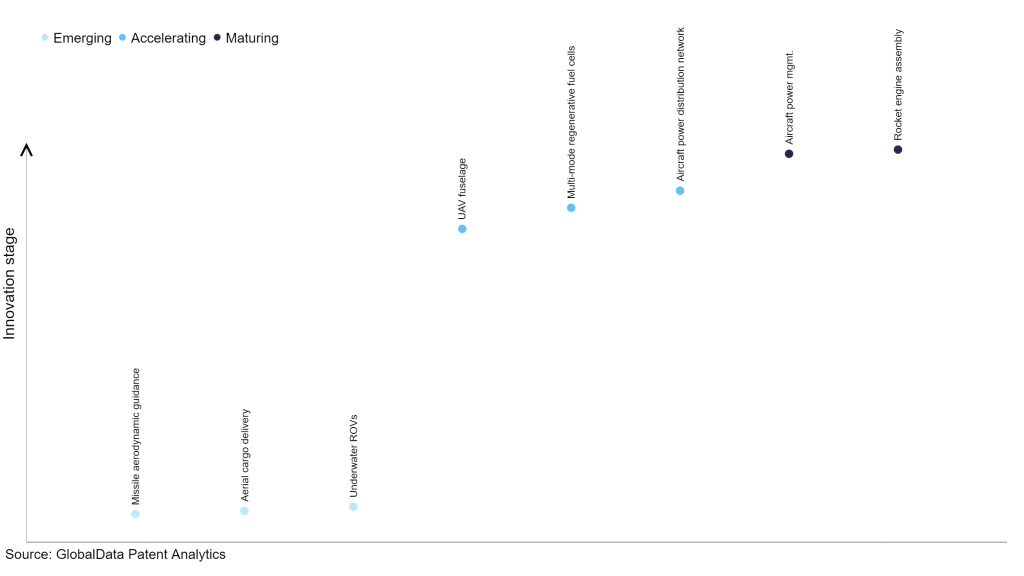The aerospace and defense industry continues to be a hotbed of patent innovation. Activity is driven by modernization imperatives, dual-use technologies, automation, and the growing importance of technologies such as artificial intelligence (AI), cloud connectivity and materials science. In the last three years alone, there have been over 84,000 patents filed and granted in the aerospace and defense industry, according to GlobalData’s report on Innovation in defense: self-calibrating scanners. Buy the report here.
However, not all innovations are equal and nor do they follow a constant upward trend. Instead, their evolution takes the form of an S-shaped curve that reflects their typical lifecycle from early emergence to accelerating adoption, before finally stabilizing and reaching maturity.
Identifying where a particular innovation is on this journey, especially those that are in the emerging and accelerating stages, is essential for understanding their current level of adoption and the likely future trajectory and impact they will have.
110 innovations will shape the aerospace and defense industry
According to GlobalData’s Technology Foresights, which plots the S-curve for the aerospace and defense industry using innovation intensity models built on over 260,000 patents, there are 110 innovation areas that will shape the future of the industry.
Within the emerging innovation stage, missile aerodynamic guidance, aerial cargo delivery, and underwater ROVs are disruptive technologies that are in the early stages of application and should be tracked closely. UAV fuselage, multi-mode regenerative fuel cells and aircraft power distribution network are some of the accelerating innovation areas, where adoption has been steadily increasing. Among maturing innovation areas are aircraft power management and rocket engine assembly, which are now well established in the industry.
Innovation S-curve for the aerospace and defense industry

Self-calibrating scanners is a key innovation area in aerospace and defense
Self-calibrating scanners is a catch-all term referring to sensor systems capable of autonomously adjusting their detection and localization capabilities using machine learning in order to continuously optimize its capacity to discern objects or phenomena of interest in a given target environment. Various types of sensors including radar, LiDAR and electro-optronic/infrared (EO/IR) systems can integrate machine learning and thus conduct iterative improvements of their intelligence gathering and surveillance capabilities.
GlobalData’s analysis also uncovers the companies at the forefront of each innovation area and assesses the potential reach and impact of their patenting activity across different applications and geographies. According to GlobalData, there are 305+ companies, spanning technology vendors, established aerospace and defense companies, and up-and-coming start-ups engaged in the development and application of self-calibrating scanners.
Key players in self-calibrating scanners – a disruptive innovation in the aerospace and defense industry
‘Application diversity’ measures the number of applications identified for each patent. It broadly splits companies into either ‘niche’ or ‘diversified’ innovators.
‘Geographic reach’ refers to the number of countries each patent is registered in. It reflects the breadth of geographic application intended, ranging from ‘global’ to ‘local’.
Patent volumes related to self-calibrating scanners
Source: GlobalData Patent Analytics
Alphabet, Aptiv, and Robert Bosch Stiftung are the leading patent filers in self-calibrating scanners. Some other leading filers in the space include General Motors, Amazon.com and Qualcomm.
In terms of application diversity, Alphabet leads the pack, while Aptiv, and Amazon.com stood in the second and third positions, respectively. By means of geographic reach, State Farm Mutual Automobile Insurance leads the pack, followed by Tom Tom and NIKE.
To further understand the key themes and technologies disrupting the aerospace and defense industry, access GlobalData’s latest thematic research report on Aerospace & Defense.
Data Insights
From

The gold standard of business intelligence.
Blending expert knowledge with cutting-edge technology, GlobalData’s unrivalled proprietary data will enable you to decode what’s happening in your market. You can make better informed decisions and gain a future-proof advantage over your competitors.



